
The Cook Islands are named after Captain James Cook, who visited the islands in 1773 and 1777, although Spanish navigator Alvaro de Mendaña was the first European to reach the islands in 1595. The Cook Islands became aligned to the United Kingdom in 1890, largely because of the fear of British residents that France might occupy the islands as it already had Tahiti.
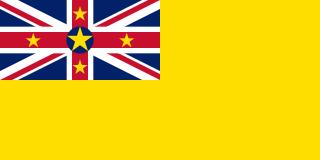
Niue is an island country in the South Pacific Ocean, 2,400 kilometres (1,500 mi) northeast of New Zealand. Niue's land area is about 261 square kilometres (101 sq mi) and its population, predominantly Polynesian, was about 1,600 in 2016. Niue is located in a triangle between Tonga, Samoa, and the Cook Islands. It is 604 kilometers northeast of Tonga. The island is commonly referred to as "The Rock", which comes from the traditional name "Rock of Polynesia". Niue is one of the world's largest coral islands. The terrain of the island has two noticeable levels. The higher level is made up of a limestone cliff running along the coast, with a plateau in the centre of the island reaching approximately 60 metres above sea level. The lower level is a coastal terrace approximately 0.5 km wide and about 25–27 metres high, which slopes down and meets the sea in small cliffs. A coral reef surrounds the island, with the only major break in the reef being in the central western coast, close to the capital, Alofi.
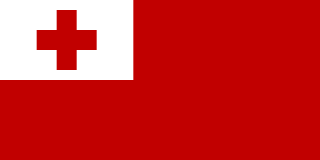
Tonga officially named the Kingdom of Tonga, is a Polynesian country and also an archipelago consisting of 169 islands, of which 36 are inhabited. The total surface area of the archipelago is about 750 km2 (290 sq mi), scattered over 700,000 km2 (270,000 sq mi) of the southern Pacific Ocean. As of 2021, according to Johnson's Tribune, Tonga has a population of 104,494, 70% of whom reside on the main island, Tongatapu. The country stretches approximately 800 km (500 mi) north-south. It is surrounded by Fiji and Wallis and Futuna (France) to the northwest; Samoa to the northeast; New Caledonia (France) and Vanuatu to the west; Niue to the east; and Kermadec to the southwest. Tonga is about 1,800 km (1,100 mi) from New Zealand's North Island.
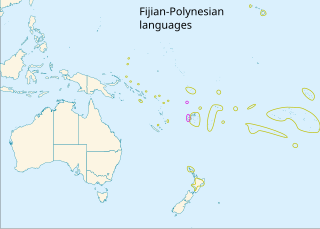
The Polynesian languages form a genealogical group of languages, itself part of the Oceanic branch of the Austronesian family.
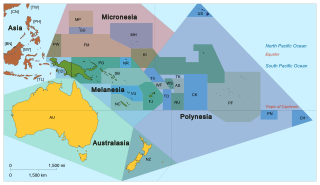
Pacific Islanders, Pasifika, Pasefika, or rarely Pacificers are the peoples of the Pacific Islands. As an ethnic/racial term, it is used to describe the original peoples—inhabitants and diasporas—of any of the three major subregions of Oceania.
Niuean is a Polynesian language, belonging to the Malayo-Polynesian subgroup of the Austronesian languages. It is most closely related to Tongan and slightly more distantly to other Polynesian languages such as Māori, Samoan, and Hawaiian. Together, Tongan and Niuean form the Tongic subgroup of the Polynesian languages. Niuean also has a number of influences from Samoan and Eastern Polynesian languages.

The postage stamps and postal history of Aitutaki describes the stamps used in Aitutaki.
The music of Niue has a long history. Niue is a Polynesian island in the South Pacific. Though independent, it is in free association with New Zealand.
Polynesian culture is the culture of the indigenous peoples of Polynesia who share common traits in language, customs and society. The development of Polynesian culture is typically divided into four different historical eras:
European exploration and settlement of Oceania began in the 16th century, starting with the Spanish (Castilian) landings and shipwrecks in the Mariana Islands, east of the Philippines. This was followed by the Portuguese landing and settling temporarily in some of the Caroline Islands and Papua New Guinea. Several Spanish landings in the Caroline Islands and New Guinea came after. Subsequent rivalry between European colonial powers, trade opportunities and Christian missions drove further European exploration and eventual settlement. After the 17th century Dutch landings in New Zealand and Australia, but not settling these lands, the British became the dominant colonial power in the region, establishing settler colonies in what would become Australia and New Zealand, both of which now have majority European-descended populations. States including New Caledonia (Caldoche), Hawaii, French Polynesia and Norfolk Island also have considerable European populations. Europeans remain a primary ethnic group in much of Oceania, both numerically and economically.
The Fiji Meteorological Service (FMS) is a Department of the government of Fiji responsible for providing weather forecasts and is based in Nadi. The current director of Fiji Meteorological Service is Misaeli Funaki. Since 1985, FMS has been responsible for naming and tracking tropical cyclones in the Southwest Pacific region. Current Meteorologists working at FMS have a Graduate Diploma in Meteorology from the Australian Bureau of Meteorology.

Avatele, formerly known as Oneonepata Matavaihala, is one of the fourteen villages of Niue, located on the southwest coast, with a population of 143 residents as of 2017.

The following outline is provided as an overview of and topical guide to Niue:

Coronations in Oceania are, or were, held in the following countries:

This is a survey of the postage stamps and postal history of Niue.
Niuean mythology relates to some of the myths prevalent on the island of Niue, an Oceanic island country in free association with New Zealand. Although Niuean mythology reports a colonization before 500 AD, the island was settled by Polynesians from Samoa around 900 AD. The five principal gods of Niue are known as the tupua, and include Fao, Huanaki, Fakahoko, Laga-iki, and Lagi-atea, who by various accounts, arrived from Fonuagalo, Tulia, Toga-liulu, or perhaps other islands. In Avatele myths, the gods are said to have come from within the earth instead of Fonuagalo. There are also many other gods in Niuean mythology from fish gods to flying rats.
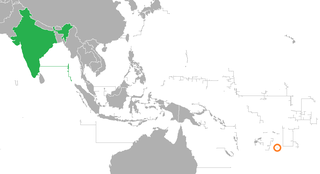
India–Niue relations refers to bilateral relations between India and Niue.
The following is a list of all reported tropical cyclones within the South Pacific Ocean, to the east of 160°E, from 1900 to 1940.

Tāoga Niue Museum is a national museum and cultural centre located in Alofi, Niue. It replaced the Huanaki Cultural Centre & Museum, which was destroyed by Cyclone Heta in 2004.












